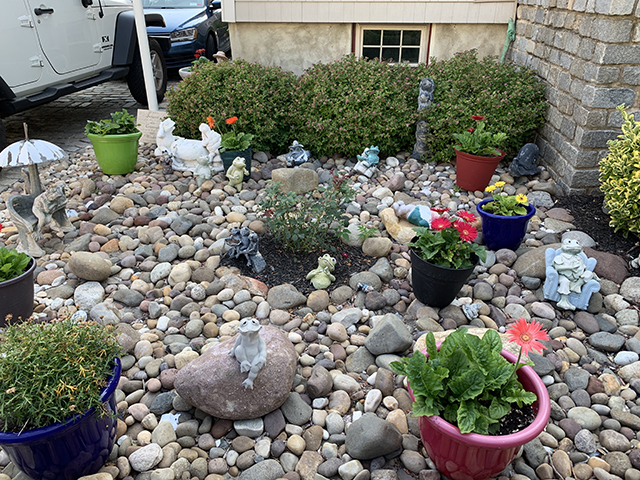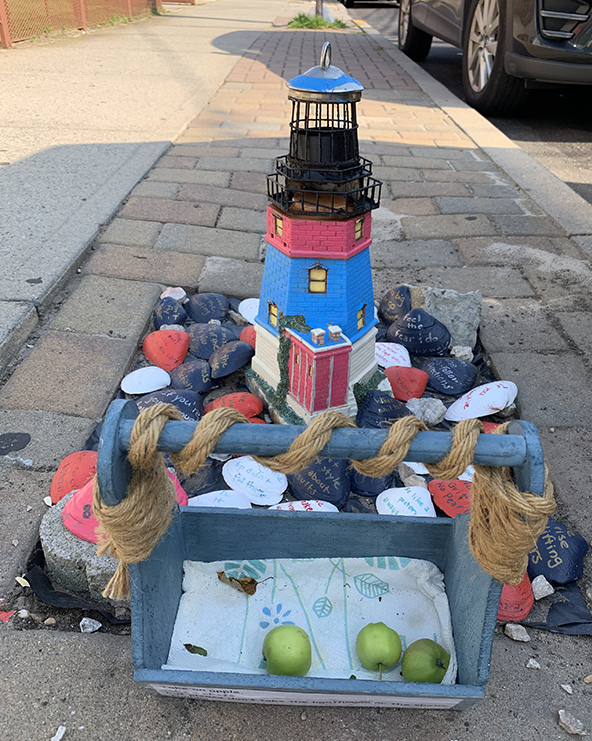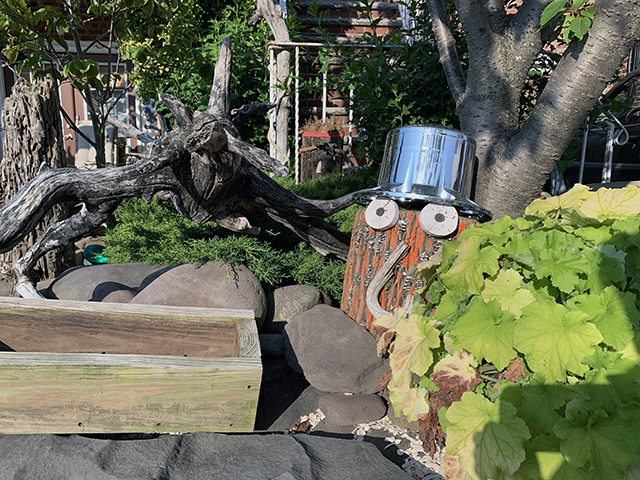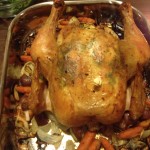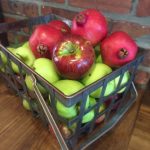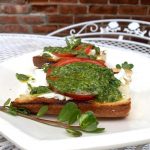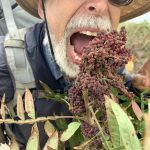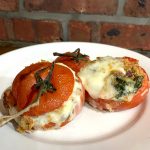by Paula D.
on August 27, 2019 9:23 am in Gardening
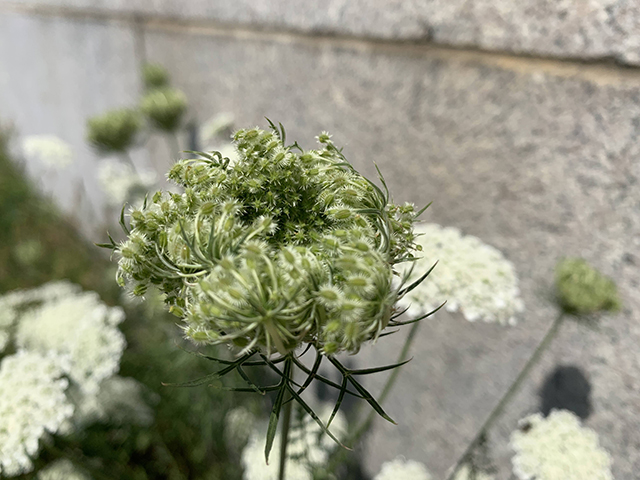
My friend Maggie Scott works for the NYC Parks Dept. Every time we hang, it turns into a deep garden-talk session. Last week, I ran into her at a girl’s dinner hosted by our mutual friend Jodi Jordan Mulvanerty. I mentioned how beautiful the Queen Anne’s Lace (Daucus Carota) looks right now by the 100th precinct and she agreed.
Queen Anne’s Lace is a wildflower in the northeast but it’s generally considered a weed. You’ll find it growing in a crack on the sidewalk or in a vacant lot. I’ve recently seen them growing on the median on Cross Bay Boulevard. But really, what’s a weed? One wouldn’t realize that the two foot tall “weed” will start to flower beautifully in late summertime. When Queen Anne’s Lace blooms, the plant produces tiny white flowers that are clustered to form a billow – like an elaborate gown of lace. Sometimes a red flower will appear from the umbel. The leaves look like ferns but much smaller in size. If you notice that type of leaf, don’t remove the plant! With such elegance, how can a species like this be considered a weed?
According to telaflora.com, “Legend has it that Queen Anne, the wife of King James I, was challenged by her friends to create lace as beautiful as a flower. While making the lace, she pricked her finger, and it’s said that the purple-red flowers in the center of Queen Anne’s Lace represents a droplet of her blood. In the language of flowers, Queen Anne’s Lace represents sanctuary.”
My mother-in-law Maureen Walsh of Walsh Properties is always posting flower photos on facebook. She posted a picture of Queen Anne’s Lace and my neighbor Ann Kirby-Payne commented that she had the flower in her wedding bouquet.
Another commenter, a family member, Millie Sarnecky mentioned placing the flowers in a vase of colored water and then watch it turn color overnight! This would be a fun project for kids and adults, maybe using beet juice as a natural dye.
Queen Anne’s lace is actually a wild carrot and the roots are edible. The time to harvest is when the plant is young, before it becomes woody. But please beware! Poisonous hemlock looks very similar and a small amount of that plant can cause respiratory failure. Maggie told me a funny way to distinguish the two from each other. Just remember, The Queen has hairy legs! The stem and leaves of the wild carrot, (Queen Anne’s Lace) have tiny hairs on it, hemlock does not. Also the root of D. Carota smells like a carrot, hemlock does not. I wouldn’t advise foraging for this plant unless you have experience. I don’t want to be responsible for an “Into The Wild” situation.
However, I would encourage you to pick the flowers and create a beautiful floral bouquet for your dining table. I’ll do this often in the summer — free flowers for inside the home arrangements are unbeatable. Bring the garden inside, as I always say.
In summary, before you pull weeds out randomly give a second thought. There are late-bloomers in Rockaway that are beautiful and important to our ecosystem. As a part two, next week I’ll be discussing the importance of Goldenrod. It has been purposely planted in Rockaway for the monarch migration.
If you’re interested in gardening, cooking, cats, or if you want to stalk a Rockaway B-Lister, find Paula on instagram @theglorifiedtomato
Previously published in The Wave.
by Paula D.
on August 13, 2019 9:21 am in Food
This is what I wait for all year: sweet, ripe, explosively delicious homegrown tomatoes! There’s nothing that compares. This season I planted three varieties: Italian Heirloom, Campar, and Burpee Beefsteak. My friend Rob Bryn’s mother, Roberta gave me the beefsteak. They’re doing the best. The plants are three feet tall and the huge tomatoes are just turning color now. She ordered them from QVC because the company name is Roberta’s. The good karma is working.

I always plant at least one heirloom.They are the “pure-breeds” of their kind. Also known as heritage tomatoes, these fruits are more delicate to grow but the reward is worth the work. They are sweeter and richer in flavor than hybrids. The variety needs to be “bred” by one pollinator for 50 years! I’m not a hybrid hater though, they too are tasty but are way easier to grow than the high-class tomato varieties. The cross-pollination makes hybrids more resistant to diseases.
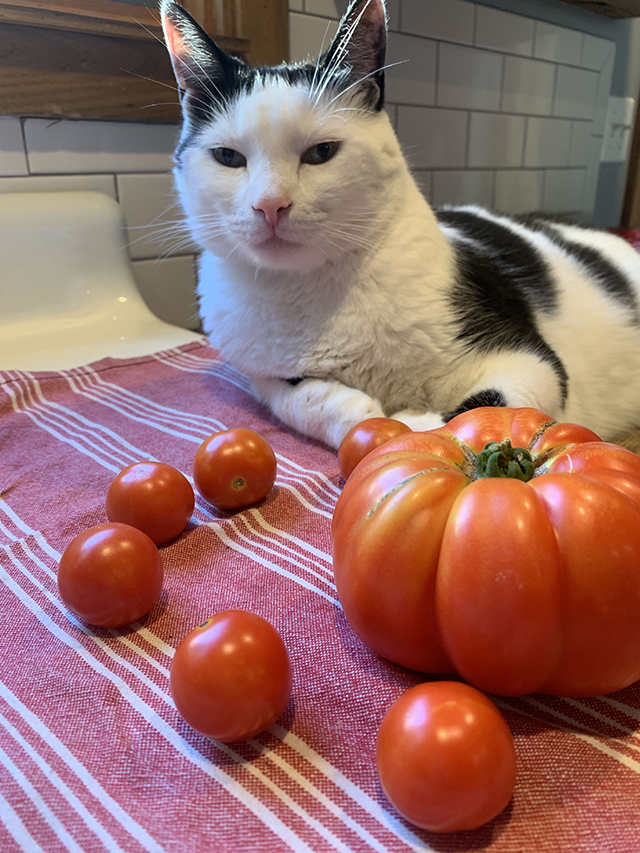
Campars, one precious Italian Heirloom and my cat Fivey who just celebrated his 6th birthday!! .JPG
This has been my best growing season for tomatoes since living here in Rockaway, but I did have some blossom-end rot. Nothing too significant. Blossom-end rot happens when you have inconsistent watering – too much water at once as we did last month. Or it can happen from a calcium imbalance. My latest batch of tomatoes show no signs of rot and look as though they will qualify for the ultimate designation “glorified tomatoes”.
I use tomatoes in everything. Therefore, it would be difficult for me to pick one recipe to share with you. I will say homegrown tomatoes are best seasoned simply. Enjoy the fruit for what it is. I like to make an effortless tomato salad with shaved red onions, sea salt, fresh pepper and a high quality olive oil (my go-to is Colavita).
Tomatoes should sit on your counter at room temperature. I was shocked to realize so many people still put tomatoes in the refrigerator. I know this because I look into my friend’s fridges, to see what they eat. My friend Katie Honan does this too. In fact, it’s an Italian thing. Most of us will look in your refrigerator and then comment, “Oh you got the Romano on sale!” or “Can I try some of that pasta salad?”, or “Looks like you need to go food shopping.” Things along those lines.
Already, I have a little tomato anxiety. They’re so good now and our growing season is so short. I don’t want to go back to store-bought tomatoes which are plucked while green and ripened on a truck somewhere on I-95 North. They end up in the supermarket, never reaching their full potential. This pains me (sad emoji face here).
But let’s not go down the rabbit whole of tomato doom. Let’s live in the present and enjoy the abundance of homegrown tomatoes here and now.
by Paula D.
on August 2, 2019 1:49 pm in Food / Recipes

A few weeks ago I wrote about the abundance of kale in my garden. Well, the dill I planted is also growing wild now. It’s called dill “weed” for a reason. And the plant bolts in the heat, so it makes sense with the heat wave last week that my herb plant is three feet tall!
The lemony, sweet and bitter flavor of dill is most pungent when it begins to flower. Snip the feathered leaves for immediate use. Wait until the flowers mature and snip those off at the stem. Put the flower heads in a clear plastic bag in a dry location. In one day or sooner, you’ll see black dill seeds,which you can store and use year-round.
The whole dill plant is edible, so make sure to use all parts including the stems which are perfect for pickling.
For Easter I made a dill cream sauce for a pan-seared salmon and that was a crowd pleaser. Dill is great with most fish. Overnight pickles seasoned with dill and garlic; sauteed carrots with dill; tomato salad with red onion, dill, and feta; potato salad and roasted chicken with dill are a few dishes I’m thinking of off the top of my head — all delicious and seasonally appropriate. If I’m feeling ambitious, I can try okroshka — a staple Russian soup served cold. It’s made with vegetables, dill, boiled potatoes, boiled eggs, kvass (a non-alcoholic fermented beverage) and a protein. There’s no dill-ema when it comes to meal choices here.
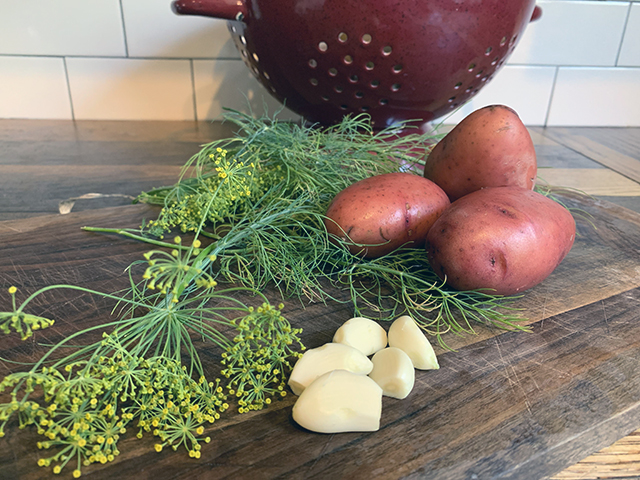
This week I decided to make potato salad which I served with veggie hot dogs and coleslaw. My husband gave it rave reviews! It was loaded with dill for a lot of punch. It’s my own recipe that I’ve made countless times. Usually I don’t measure but I made it a point this time so I can share the recipe with you. I hope you give it a try, enjoy.
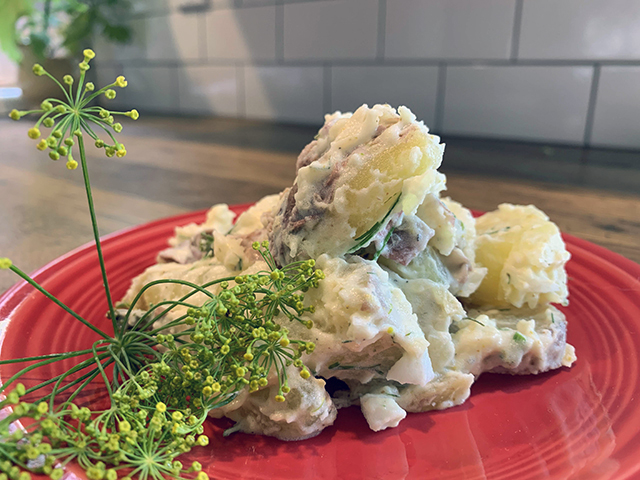
Paula’s Potato Salad
Ingredients:
1 bag red potatoes
1/2 large onion
5 oz. mayonnaise (use Hellman’s and don’t get the low-fat, it tastes bad!)
1 tablespoon mustard
¼ cup white vinegar
5 long sprigs of dill and some for garnish.
4 cloves garlic
Salt and pepper to taste
Directions: Quarter the potatoes (leave the skin on) and bring to a boil until soft. Drain and let them cool for five minutes. Dice the onions and garlic. Chop the dill. In a large bowl add all ingredients. Thoroughly mix so the potatoes are covered well. Refrigerate and let the potato salad sit for 20 minutes before serving.
follow me on instagram – @theglorifedtomato for all things summer gardening.







